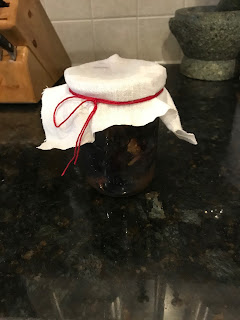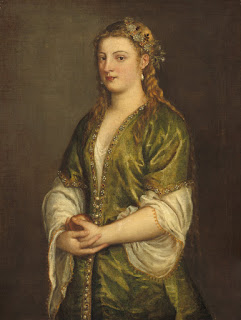I was involved in the Meridian Largesse Swap this summer, where each of us got a name and some information on that person and their persona and had to make a gift for that person. (I received an enchanting flag fan with a hand-turned handle) The actual exchange was at RUM but my recipient could not attend. Luckily, she is in my Barony, so I gave her the gift tonight at our monthly business meeting.
Lady Stella dresses in both late 15th century Italian and Korean. Since I know very little about Korean culture, I decided to do something for her Italian persona.
Decorative aprons were a big thing in the 16th century, but the earliest I could date one was to 1507.*
Portrait of a Woman (La Muta)
Raphael
c1507
Galleria Nazionale della Marche, Urbino, Italy
Mistress Peryn and the Loggia Vecchio group found me examples of several late 15th century aprons, but they weren't specifically decorative.
Detail from Birth of St John the Baptist
Dominic Ghirlandaio
c1486-1490
Capella Tornabuoni, Santa Maria Novella, Florence
Detail from St Martin Sharing His Cloak Fresco (?) by Dominic Ghirlandaio
last quarter of the 15th century
San Martino del Vescova
Piazza San Martino, Via Dante Alighieri
Florence, Italy
This photo of San Martino del Vescovo is courtesy of TripAdvisor
The 16th-century aprons often had lace or fancy embroidery, but the 15th-century examples did not appear to include either. But a plain apron did not seem like much of a gift, either.
I had several examples of drawn work going back as early 1320, but on household linen, not clothing.
The Presentation of the Christ Child in the Temple
Giotto
c. 1320
Isabella Stewart Gardner Museum, Boston
Detail from The Circumcision
Master of Saint-Severin (German, Cologne School)
c1490
The Louvre, Paris**
The earliest example of drawn work on clothing I could find was 1505
Detail from Bacchus and Ariadne
Tullio Lombardo
c. 1505-10
Kunsthistoriches Museum, Vienna
Ideally, I wanted more robust documentation, but this was for a gift, not an A&S entry so I decided not to stress (too much) and start on construction.
I chose ramie for the material. There were some informal conversations at the Jamestown conference about ramie being closer to the linen one would find in period than any reasonably available linen. I had some ramie that I had cut into a chiton only to find it was too stiff for my taste. But a little stiffness for an apron could be a good thing. And bonus -all my white linen was in lengths suitable for camicia, so using the ramie was repurposing a failed project and being more efficient with my fabric resources.
Drawing threads to square the ramie was easier than I expected -definitely easier than pulling threads from fabrics-store linen. Since Stella is significantly thinner than I am, I took some width off each side to make the ties from and ended up with a rectangle roughly 35"x45" wide.
I used hem stitch to hem three sides of the rectangle and then got to the fun part of the project. I wanted a pretty but not
too elaborate design on the apron. I didn't think it was suitable for the late 15th century and I was also writing 2 classes for RUM so I wanted to be able to finish the apron on time.
I decided on this design
The time invested in carefully planning and marking the threads to be removed paid off and there were no "oops" moments where lines didn't match up (thankfully). I drew the threads into an X pattern and used a satin stitch on the corners where the thread lines met.
The corners warped out of shape a bit, but I think I've figured out how to keep that from happening next time I have drawn work corners. I added a diagonal bar of buttonhole stitches in each corner to stabilize them and the triangle shape became much less noticeable, even to my hyper-critical eye.
The last step was to gather the rectangle onto a long narrow piece for the waistband and ties. I really liked the ramie for an apron, it had a nice body to it. A light coat of spray starch and a good ironing made it look quite nice indeed.
All in all, it was a pleasant, relatively zen project that was fun to work on that I finished with time to spare before RUM. Better still, Stella seemed quite happy to receive it. Now I need to make a pretty apron for myself!
I am hoping that Stella will send me a picture of her wearing it.
Until then, this picture of the apron laid against my gown for contrast will have to do.
*Full disclosure: I did not do a lot of in-depth research, just some searches of paintings
**Despite thinking I had sloid provenance on this example, I cannot find a painting by this name or this artist in the Louvre online collection























